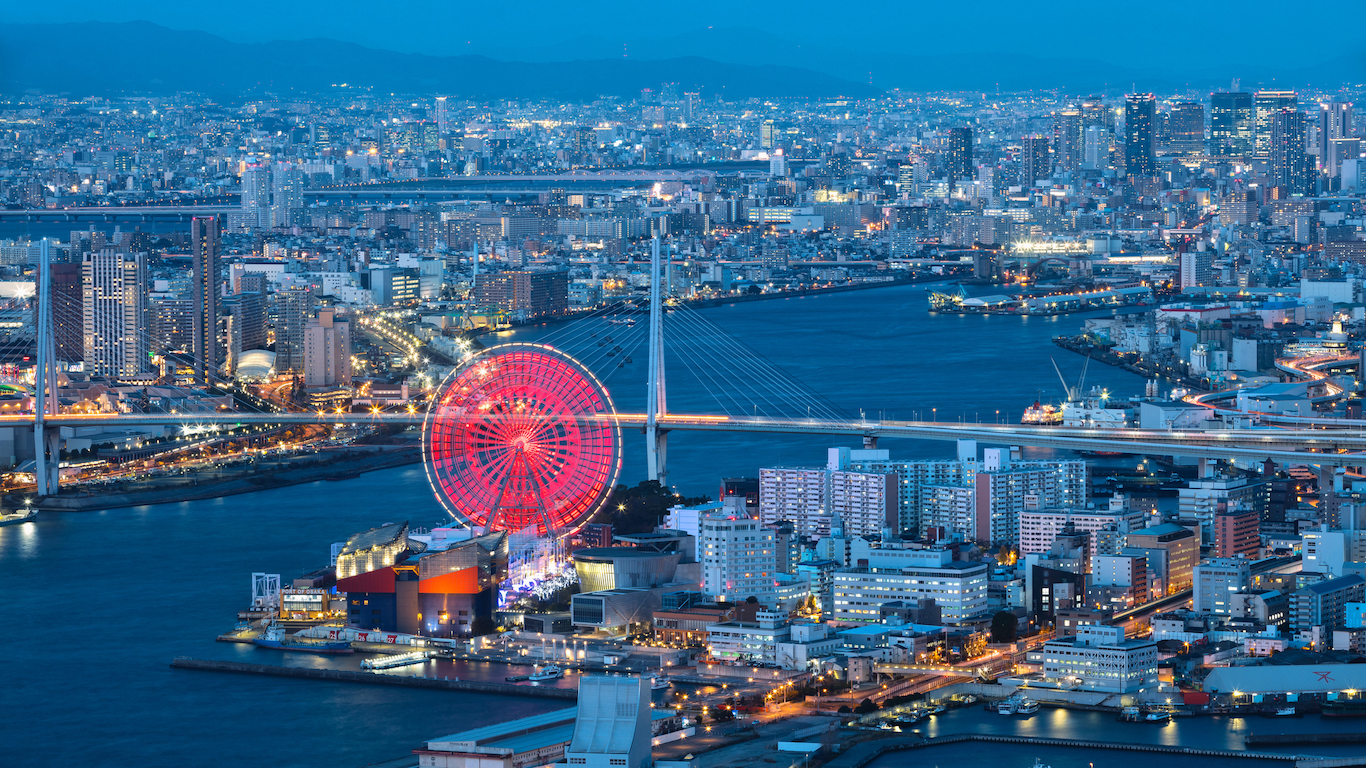
Human development reached an important and challenging milestone in 2014. That year, the United Nations announced that more than half of the world’s population lived in urban areas. The news raised questions about issues such as disease control, food production, education, housing, employment, and migration.
Today, 55% of the global population is urbanized, and by 2030 the U.N. projects that 60% of the global population will be urbanized. In the nearly five years since the world discovered this global demographic shift, the number of megacities — defined as cities with populations greater than 10 million — grew from 28 in 2014 to 33 in 2018, more than triple the number in 1990.
To identify the world’s 33 megacities, 24/7 Wall St. used the U.N.’s data booklet, “The World’s Cities in 2018.” All data on population, population projections, and the percentage of a nation’s population residing in urban areas are from this source.
It is important to note that there are no standard global criteria for determining the boundaries of a city for the purpose of population studies. Some estimates look only at the population inside a city’s administrative boundaries, known as the “city proper” population. Other population measures include surrounding suburban communities that have economic ties to a nearby urban core but can stretch for hundreds of square miles through small farming communities and national parks.
Click here to see the world’s 33 mega cities
Click here to see our detailed findings and methodology
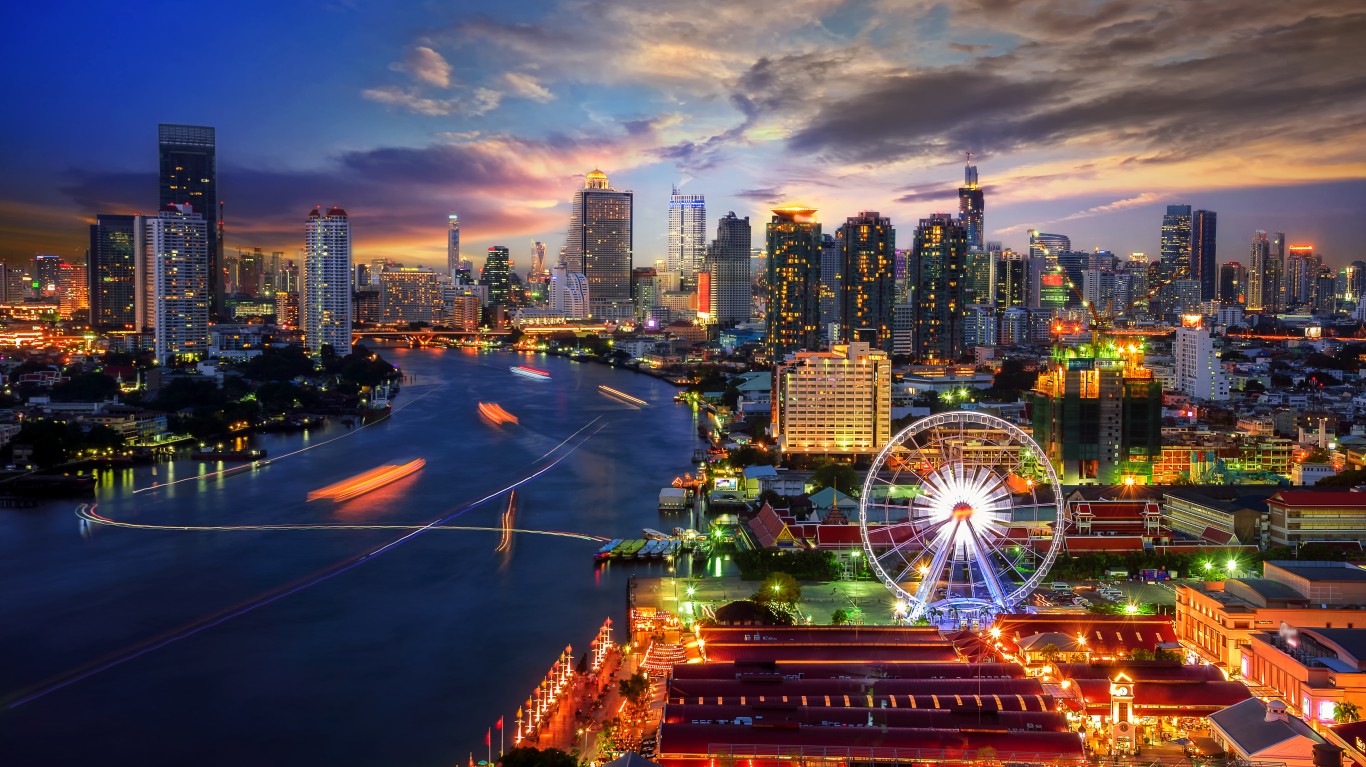
33. Krung Tep (Bangkok), Thailand
> 2018 population: 10.2 million
> 2000-2018 population growth: +58.8%
> Pct. of Thailand’s population: 14.7%
> Est. 2030 population: 12.10 million
With its ancient palaces, pulsating nightlife, and nearby tropical getaways, Thailand’s capital is one of the most visited tourist destinations in the world. Situated on the Chao Phraya, one of the region’s most important rivers for trade and rice production, Bangkok has historically been an important trading post and is today the country’s urban nerve center. Though it’s known as the Land of Smiles, Thailand has endured sometimes caustic urban-rural divisions, with 80% of the country’s poor living outside the relatively prosperous capital.
[in-text-ad]
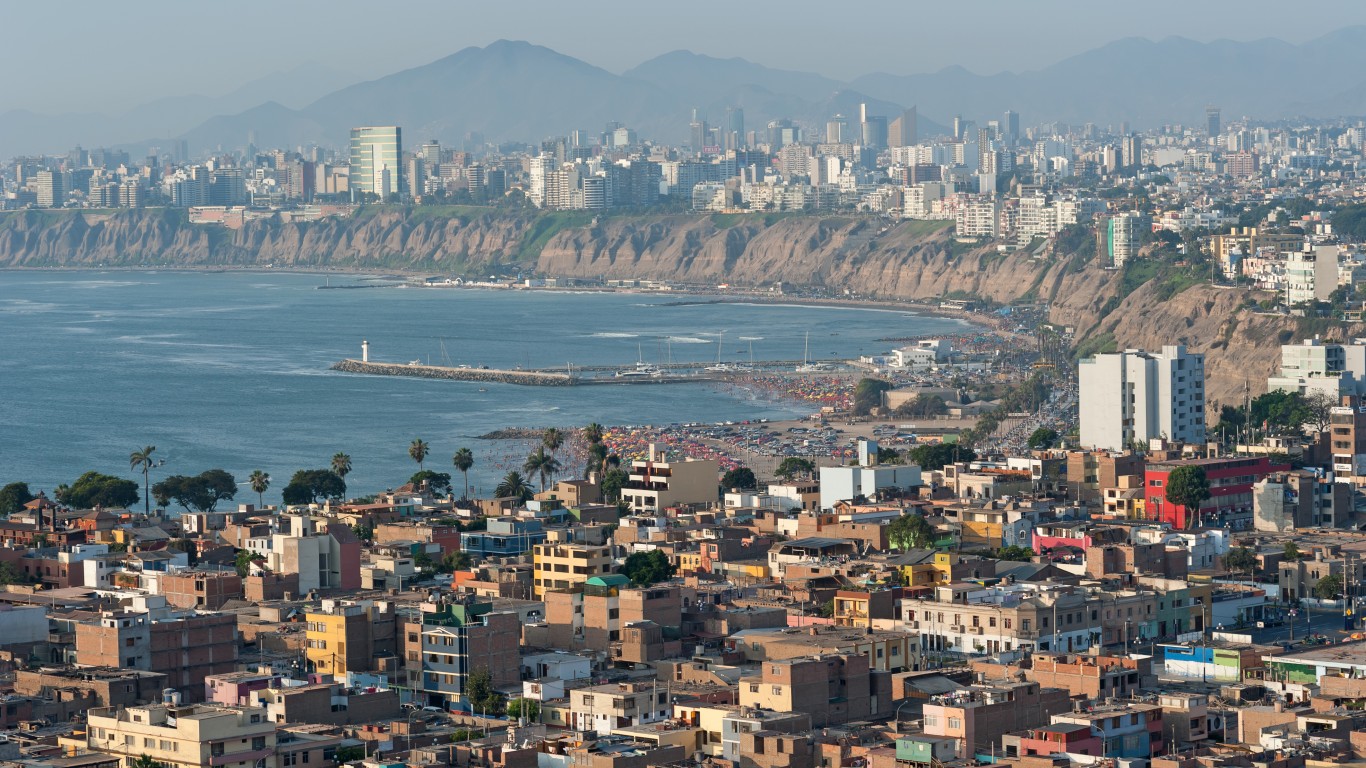
32. Lima, Peru
> 2018 population: 10.4 million
> 2000-2018 population growth: +42.5%
> Pct. of Peru’s population: 31.9%
> Est. 2030 population: 12.27 million
Surrounded by a coastal desert, Lima, which is situated on the Pacific Ocean, is Peru’s commercial and political center. This explains why nearly a third of the country’s population resides there. The city, with its modem condos rising above pre-colonial ruins, is the second most arid world capital after Cairo. Lima’s proximity to the Pacific makes it an ideal destination for both surfers and seafood fans. Once a tranquil city, Lima is now a gritty and noisy metropolis thanks to rapid economic development. The country was one of Latin America’s fastest growing economies between 2002 and 2013, according to the World Bank.
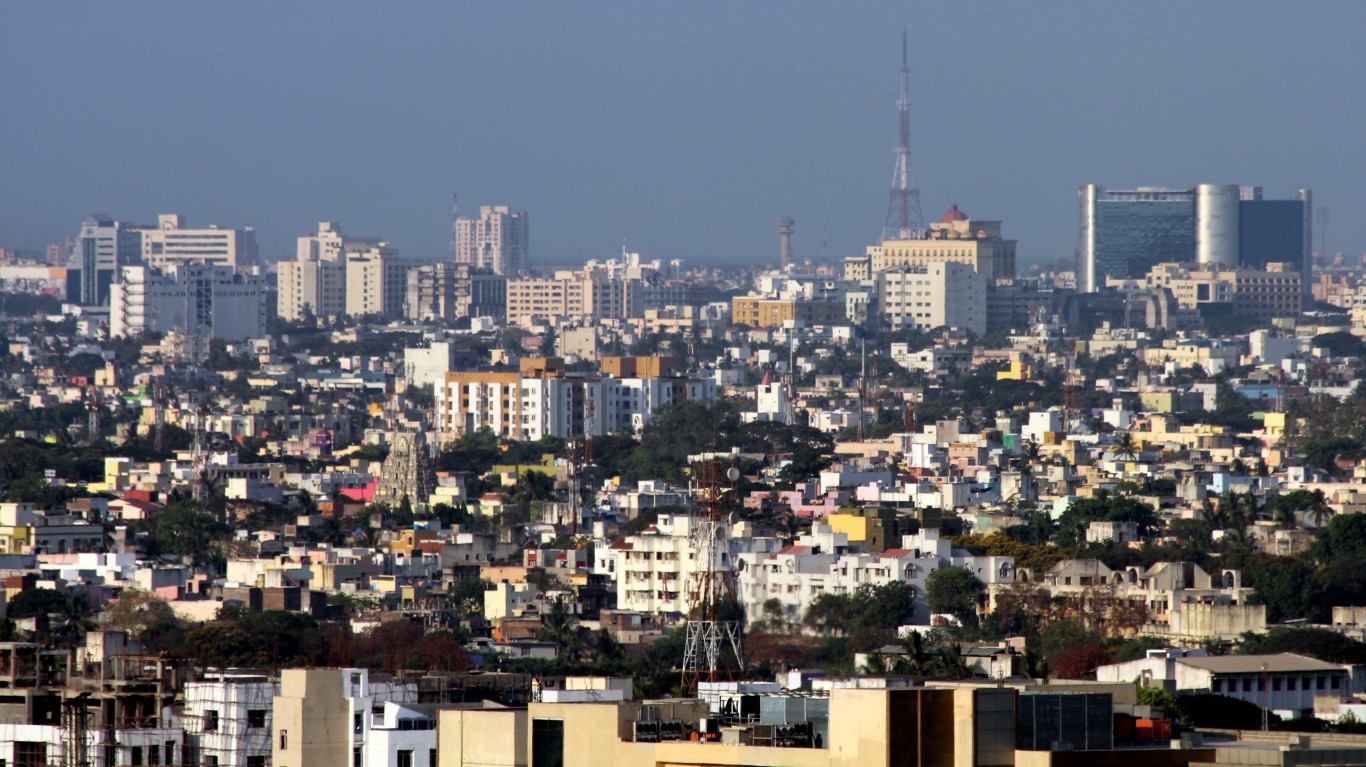
31. Chennai (Madras), India
> 2018 population: 10.5 million
> 2000-2018 population growth: +58.6%
> Pct. of India’s population: 0.8%
> Est. 2030 population: 13.81 million
Formerly known as Madras, Chennai, the capital of India’s southernmost state, Tamil Nadu, is the smallest of five megacities in India. The city originated as a town built around a British trading post in the 17th century and has grown into a bustling urban center with an industrial emphasis on automotive, electronics, and health care. It is also one of the largest information technology hubs. With hundreds of Hindu temples and several nearby beaches along the Bay of Bengal, Chennai is also one of South India’s most popular domestic and foreign tourism destinations.
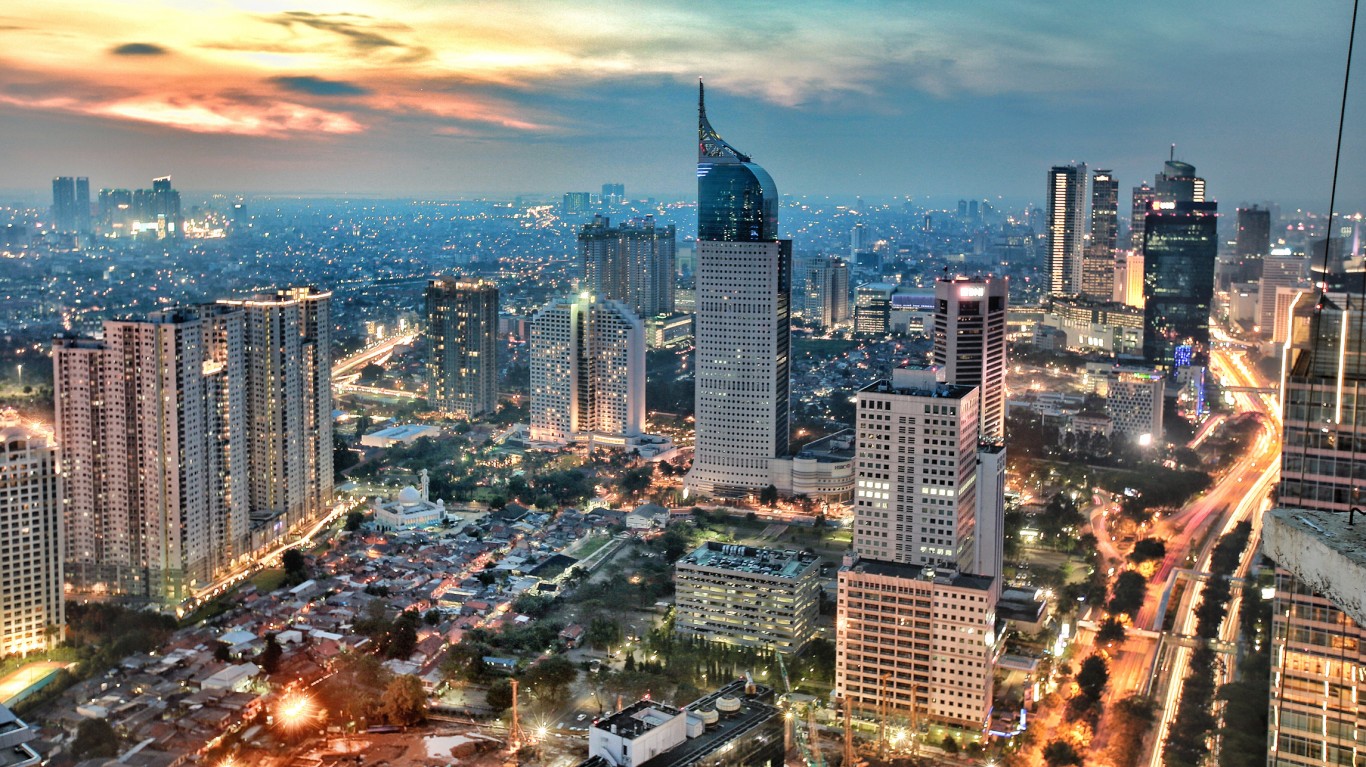
30. Jakarta, Indonesia
> 2018 population: 10.5 million
> 2000-2018 population growth: +25.4%
> Pct. of Indonesia’s population: 3.9%
> Est. 2030 population: 12.69 million
Indonesia’s capital, along with Manila and Bangkok, is one of the three megacities in Southeast Asia’s. Located on the northwest coast of Java (the country’s fourth largest and by far most populous island), Jakarta is the crowded, traffic-snarled, beating heart of this archipelago nation of 269 million people. Indonesia is Southeast Asia’s largest economy and the world’s tenth largest, and many of its non-agricultural economic engines are based in the capital, with its largest manufacturing industries involved in automotive, electronics, medical devices, and chemicals. As in many of the world’s megacities, poverty and pollution pose major challenges.
[in-text-ad-2]

29. Bogotá, Colombia
> 2018 population: 10.6 million
> 2000-2018 population growth: +67.1%
> Pct. of Colombia’s population: 21.4%
> Est. 2030 population: 12.34 million
Bogotá is one of the world’s 13 megacities that is also a national capital. Located on a high central Andean plateau, Bogotá is also the political, cultural, and financial center of the second most populous Spanish-speaking country in the world after Mexico and the second most populous South American country after Brazil. The city is a major destination for foreign direct investment in Latin America, with many foreign companies basing their regional operations there. Bogotá‘s street crime remains a concern, and local polls show public skepticism of the justice system, but gone are the days of the city’s high violent crime rates of the mid-’90s.
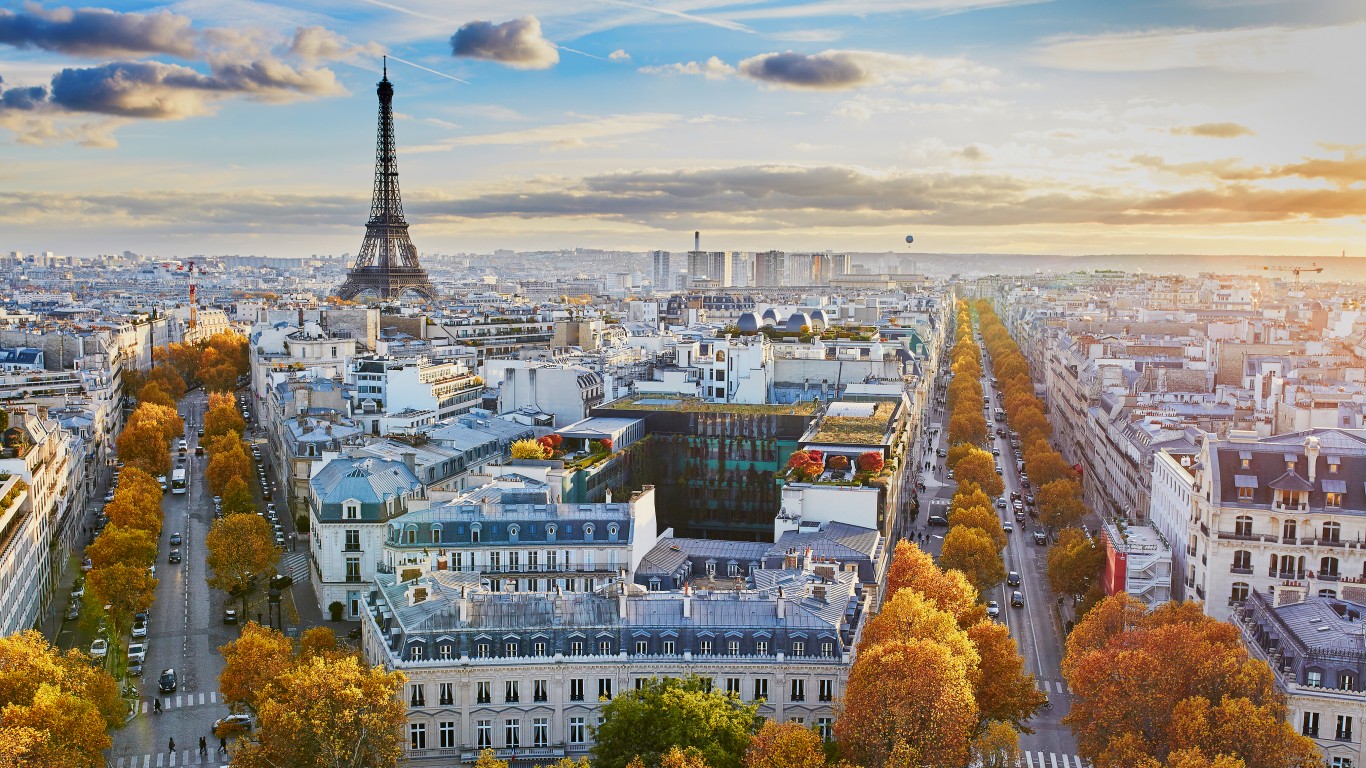
28. Paris, France
> 2018 population: 10.9 million
> 2000-2018 population growth: +12.0%
> Pct. of France’s population: 16.7%
> Est. 2030 population: 11.71 million
The City of Light, founded as a fortified settlement on an island in the Seine River about 2,300 years ago, is Western Europe’s only megacity. Paris is one of the most culturally significant cities in Western civilization and is today a major financial, commercial, and tourist center in the European Union. Paris accounts for 15% of the country’s gross domestic product, according to the Cologne Institute for Economic Research.
[in-text-ad]

27. Bengaluru (Bangalore), India
> 2018 population: 11.4 million
> 2000-2018 population growth: +105.0%
> Pct. of India’s population: 0.8%
> Est. 2030 population: 16.23 million
This capital city of India’s southern Karnataka state is the country’s information technology hub and one of the fasted growing cities in South Asia. Indians continue to flock to the city’s burgeoning software and IT industries. Nicknamed the “Silicon Valley of India,” Bangalore is an economic powerhouse and, according to one study by management consultant McKinsey, is on track to become the single largest IT cluster in the world by 2020. Like other major Indian cities, Bangalore also boasts tourist attractions and offers a local base for side trips to nearby natural and historical sites.
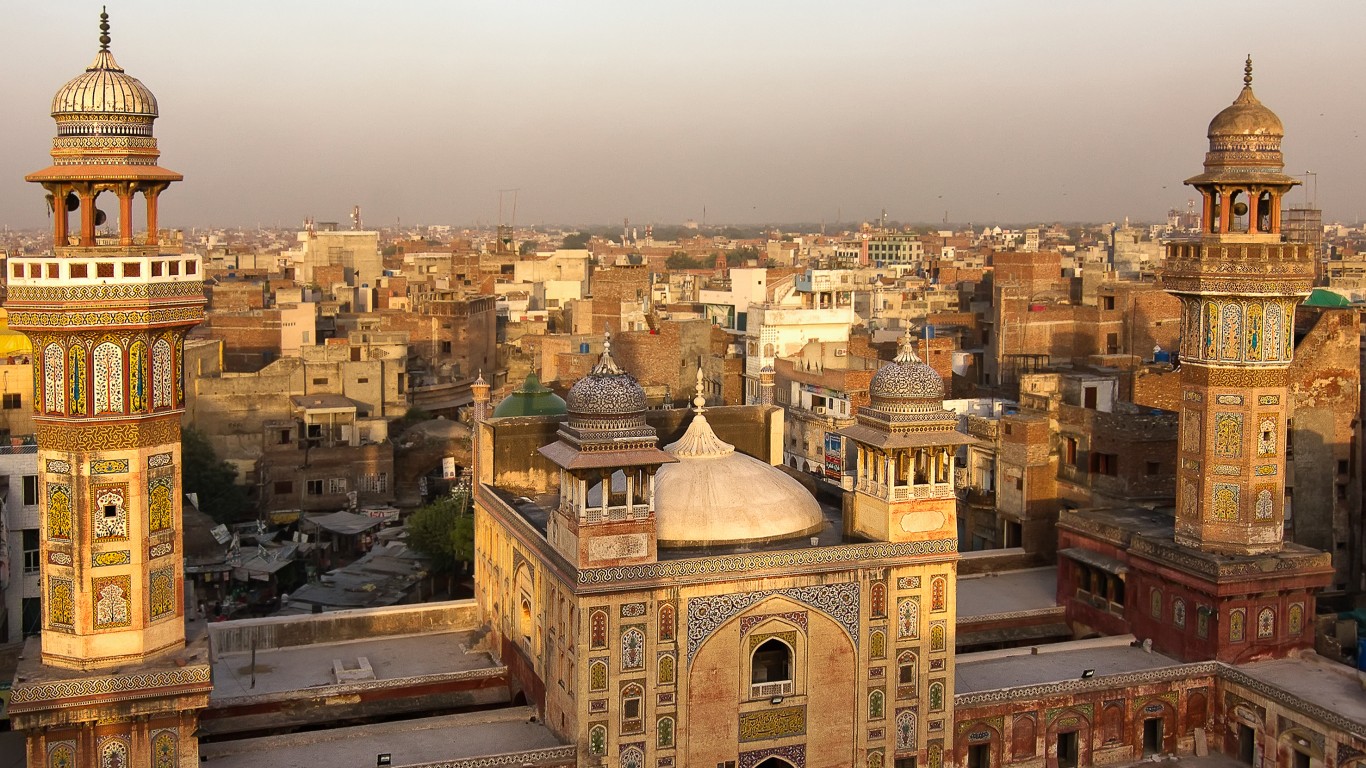
26. Lahore, Pakistan
> 2018 population: 11.7 million
> 2000-2018 population growth: +110.5%
> Pct. of Pakistan’s population: 5.8%
> Est. 2030 population: 16.88 million
Lahore is the smaller of two megacities in Pakistan, the other being Karachi. The capital of Punjab province, on the eastern border with India, Lahore is a historically important city boasting impressive Mughal and colonial-era architecture. Evidence of early settlement in the area dates back 5,000 years, and documents citing Lahore by name date back to at least the year 982. Today, the city is grappling with the challenges of rapid urbanization in a country experiencing the fastest pace of rural-to-urban migration in South Asia.
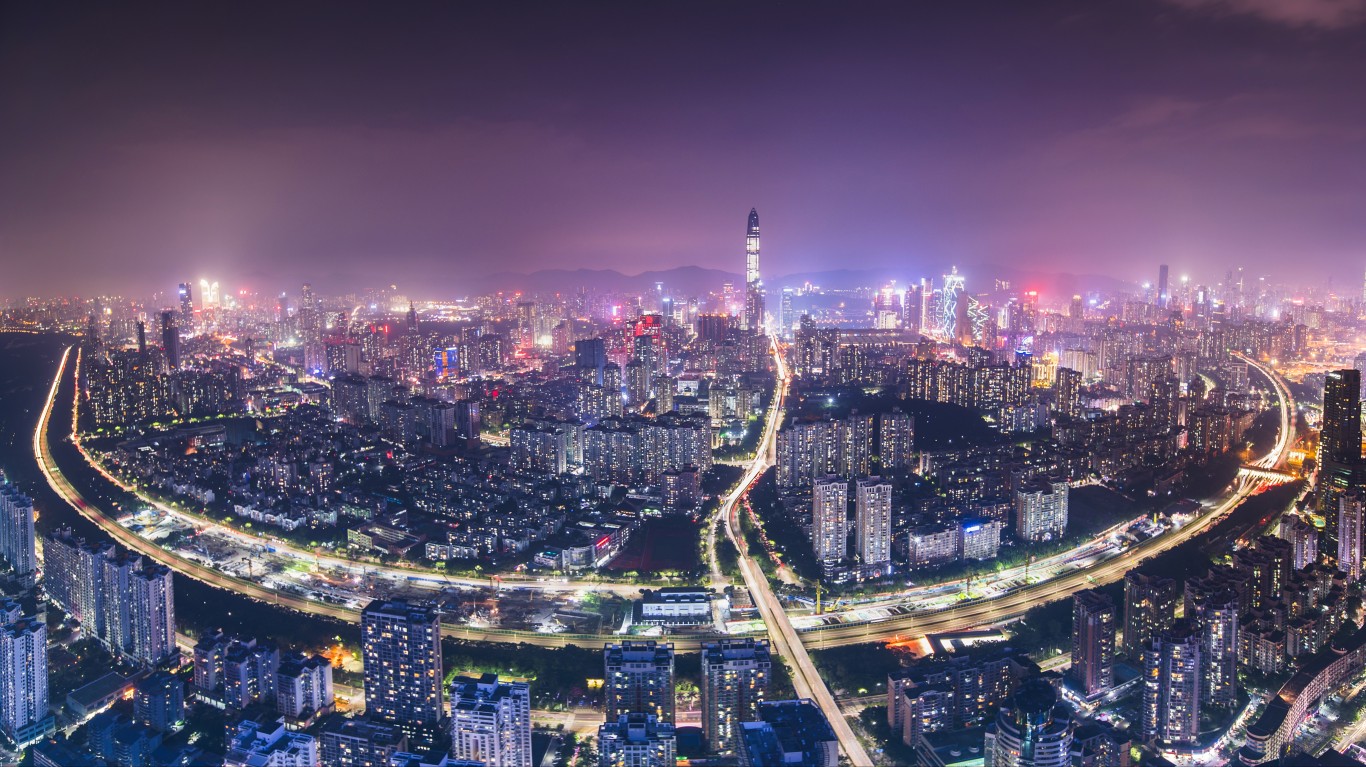
25. Shenzhen, China
> 2018 population: 11.9 million
> 2000-2018 population growth: +81.8%
> Pct. of China’s population: 0.8%
> Est. 2030 population: 14.54 million
Shenzhen is the smallest of the six Chinese megacities. Over the past 40 years, the city has turned from a small South China Sea port city of 30,000 to a smoggy, crowded, humming Chinese manufacturing powerhouse. This growth came in droves after the People’s Republic of China opened the doors to foreign investment in 1980 in several “special economic zones” along its extensive coast. The city has been called the “Silicon Valley of China,” and it attracts a heavy flow of tourists (mostly from Hong Kong, which it borders) drawn to the cheap electronics and other locally manufactured consumer goods.
[in-text-ad-2]
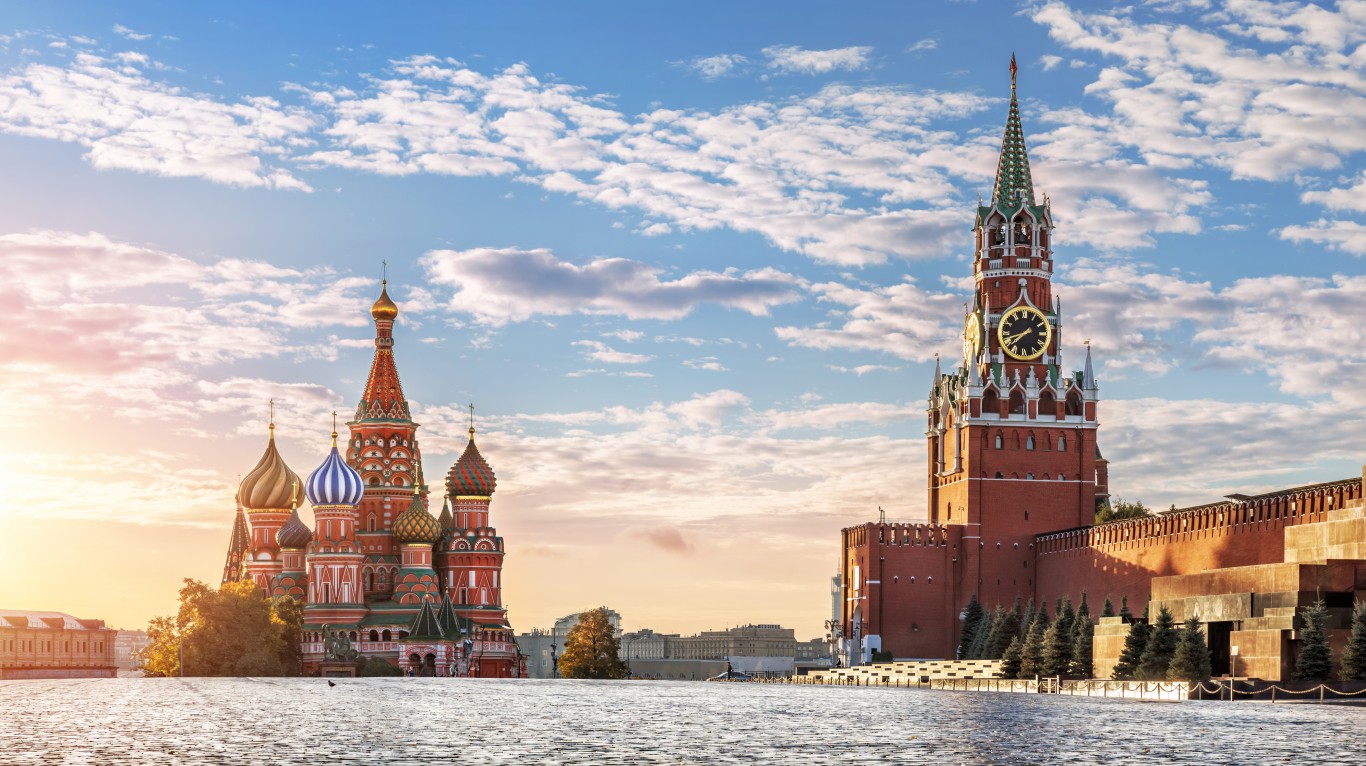
24. Moskva (Moscow), Russian Federation
> 2018 population: 12.4 million
> 2000-2018 population growth: +24.0%
> Pct. of Russian Federation’s population: 8.6%
> Est. 2030 population: 12.80 million
As Paris is to Western Europe, Moscow is the only megacity in Eastern Europe. The capital of the Russian Federation was first mentioned in historical documents in the middle 12th century and has since played a keystone role in Russian history. Moscow has been Russia’s political, educational, scientific, and industrial heart since at least the time of the Russian Empire in the 18th century. For the past six centuries, the city has also been the spiritual center of the Russian Orthodox Church. In many countries, power and economic clout is centralized in the capital, and this is especially the case in Russia.
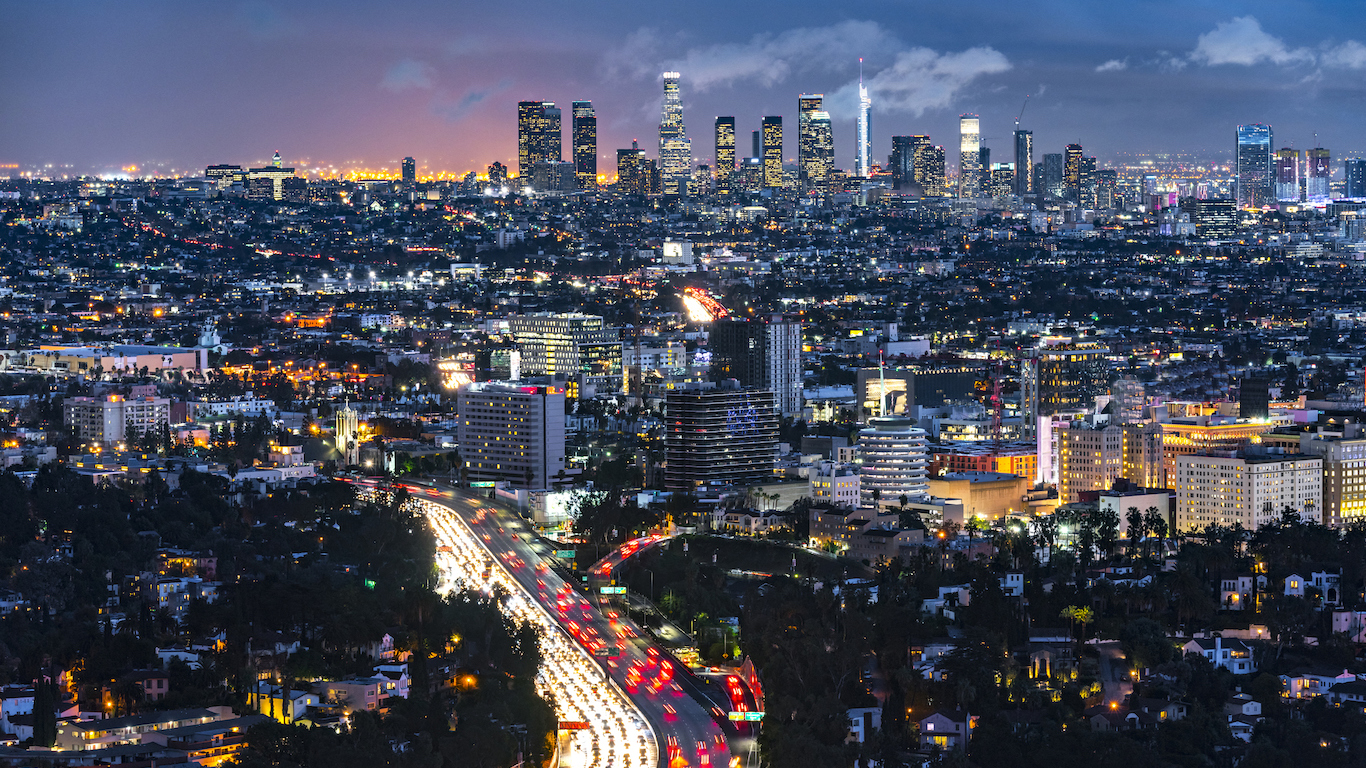
23. Los Angeles-Long Beach-Santa Ana, United States of America
> 2018 population: 12.5 million
> 2000-2018 population growth: +5.6%
> Pct. of United States of America’s population: 3.8%
> Est. 2030 population: 13.21 million
The Los Angeles metro area is one of two U.S. megacities on this list, though it is considerably less populous than the New York City metro area. Like the Big Apple, the City of Angels is a major U.S. economic hub. It’s not just the main home of the country’s entertainment industry, but also home to the world’s third largest port complex (the ports of Long Beach and Los Angeles) outside of mainland China by container volume. Los Angeles is also a major tourism destination, drawing a record 50 million visitors in 2018.
[in-text-ad]

22. Guangzhou, China
> 2018 population: 12.6 million
> 2000-2018 population growth: +61.8%
> Pct. of China’s population: 0.9%
> Est. 2030 population: 16.02 million
This provincial capital of Guangzhou is a Chinese megacitiy located in the industrial, densely populated Pearl River Delta near Hong Kong. Due to their proximity to each other, the nine big mainland cities of this region (including Shenzhen, another Chinese city on this list) are considered by the World Bank to be the world’s largest urban cluster. Located at a confluence of rivers about 90 miles from the South China Sea coast, Guangzhou, has been one of China’s commercial and trading centers for centuries and was the first port regularly visited by European traders, who called it Canton.

21. Kinshasa, Democratic Republic of the Congo
> 2018 population: 13.2 million
> 2000-2018 population growth: +114.5%
> Pct. of Democratic Republic of the Congo’s population: 15.7%
> Est. 2030 population: 21.91 million
The African continent has three megacities: Lagos, Cairo, and Kinshasa. The capital of the Democratic Republic of Congo spreads out from the banks of the Congo River and is surrounded by farmed savanna. The city is one of sub-Saharan Africa’s industrial and commercial hubs, with industries largely focused on consumer goods like beer and textiles. Despite improvements in the sub-Saharan Africa’s economy, poverty and hunger remain critical challenges among Kinshasa city dwellers. The rapid influx of rural residents into the city is also putting pressure on infrastructure, especially in transportation.

20. Tianjin, China
> 2018 population: 13.2 million
> 2000-2018 population growth: +89.1%
> Pct. of China’s population: 0.9%
> Est. 2030 population: 15.75 million
This northern Chinese megacity on a heavily industrialized inlet of the Yellow Sea has historically been a vital transport and trading center due to its role as the gateway to the country’s capital, Beijing, about 65 miles to the northwest. The city is so vital to China that it is one of the country’s four municipalities that fall under direct control of the central government. (The other three are Beijing, Chongqing, and Shanghai.) Owing to its rich cosmopolitan history, Tianjin features numerous historical attractions, but like other Chinese urban centers it struggles with air pollution and trade-related congestion.
[in-text-ad-2]

19. Rio de Janeiro, Brazil
> 2018 population: 13.3 million
> 2000-2018 population growth: +17.6%
> Pct. of Brazil’s population: 6.3%
> Est. 2030 population: 14.41 million
This festive, scenic coastal city known for its beautiful beaches and crowded slums is the smaller of Brazil’s two megacities and one of six megacities in Latin America. Rio accounts for 11% of Brazil’s GDP, with key industries including finance, mining, health care, retail, and of course tourism. A steady influx of migrants from rural Brazil continues to feed the ramshackle squatters’ camps that receive little or no services form the state. Some of these camps evolved into shanty towns, known as favelas, on the edges of the city.

18. Lagos, Nigeria
> 2018 population: 13.5 million
> 2000-2018 population growth: +84.9%
> Pct. of Nigeria’s population: 6.9%
> Est. 2030 population: 20.60 million
Lagos, in southwestern Nigeria, is one of Africa’s three megacities. The city has rapidly become a center of regional commerce, finance, and cargo transport. Spurred by security concerns, the Nigerian government moved the capital from Lagos to the centrally located planned city of Abuja in 1991, but this did not stop Lagos from becoming the hub of Africa’s largest economy. Lagos alone makes up well over half of Nigeria’s industrial and commercial activity. But critical challenges in transforming Nigeria’s economy remain, most notably: corruption. According to Transparency International, an international anti-corruption watchdog, Nigeria ranks low in administrative transparency.
[in-text-ad]
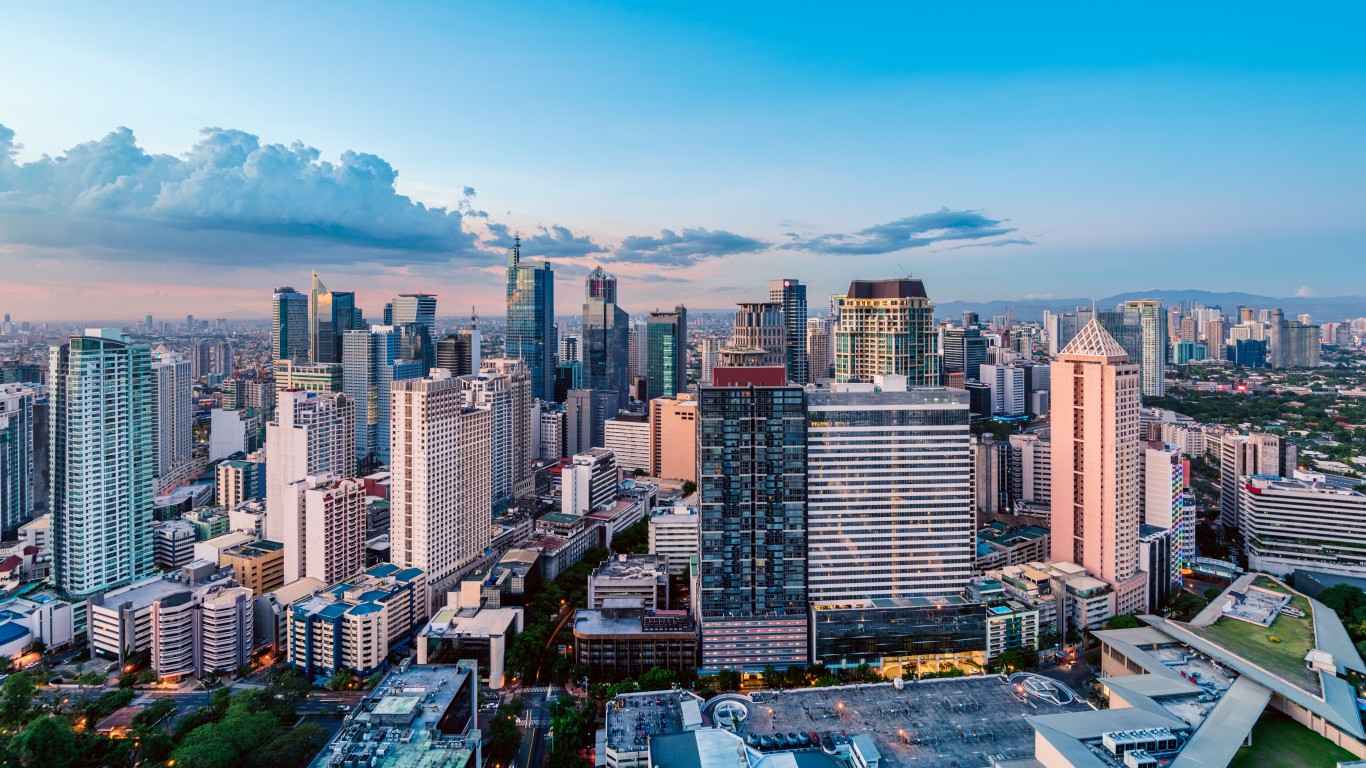
17. Manila, Philippines
> 2018 population: 13.5 million
> 2000-2018 population growth: +35.4%
> Pct. of Philippines’ population: 12.7%
> Est. 2030 population: 16.84 million
The capital of the Philippines is the largest of the three Southeast Asian megacities (the other two are Jakarta and Bangkok), and it is the nation’s economic, political, and cultural center. The sprawling coastal metropolis is located on Luzon, the country’s largest island. The city is also the country’s manufacturing, transport, and financial center. Metro Manila — which includes the city proper and the surrounding metropolitan area — suffers from problems familiar to other big cities in developing countries, including air pollution, traffic congestion, street crime, and urban poverty. This year, city officials broke ground on the country’s first subway system.

16. Kolkata (Calcutta), India
> 2018 population: 14.7 million
> 2000-2018 population growth: +12.1%
> Pct. of India’s population: 1.1%
> Est. 2030 population: 17.58 million
The capital of India’s West Bengal state is the one of India’s five megacities and the country’s third most populous behind Delhi and Mumbai. Located on the banks of the Hugli River about 100 miles from the Bay of Bengal, Kolkata is a historic transit point and the main urban center of eastern India. As in other rapidly urbanizing parts of developing world, Kolkata faces immense challenges in fixing traffic congestion, housing, and urban poverty. One of the city’s biggest problems is urban sprawl that outpaces the local government’s ability to provide basic services and infrastructure.

15. Istanbul, Turkey
> 2018 population: 14.8 million
> 2000-2018 population growth: +68.7%
> Pct. of Turkey’s population: 18.0%
> Est. 2030 population: 17.12 million
Over more than 2,500 years, Istanbul has grown from an ancient Greek colony (Byzantium) into the largest metropolitan area in the region, which has historically bridged Europe and Asia. For much of that history, Istanbul has been one of the most coveted cities in the world due to its location straddling the global trade chokepoint of the Bosporus Strait. Istanbul, located about 220 miles from Turkey’s capital, Ankara, is the economic and cultural center of the country. In addition to being a popular tourist destination, Istanbul accounts for nearly 40% of the country’s GDP, while employing over a third of the country’s industrial labor force.
[in-text-ad-2]

14. Chongqing, China
> 2018 population: 14.8 million
> 2000-2018 population growth: +88.7%
> Pct. of China’s population: 1.0%
> Est. 2030 population: 19.65 million
Located on the banks of the upper Yangtze River in central China, Chongqing is the country’s only megacity that isn’t located close to a coastline. Owing to its significance as a center of development for western China, the city is one of the country’s four municipalities that fall under direct control of the central government. Central Chongqing, located along the banks of Yangtze River tributary, is marked by the surviving architectural remnants of its past shadowed by a modern city skyline. The city, known as the gateway to the scenic Three Gorges river valleys, boasts numerous tourist attractions.

13. Buenos Aires, Argentina
> 2018 population: 15.0 million
> 2000-2018 population growth: +19.7%
> Pct. of Argentina’s population: 33.5%
> Est. 2030 population: 16.46 million
The Argentine capital is one of Latin America’s six megacities and the third largest urban area in the Western Hemisphere after Mexico City and São Paulo. It is also home to the largest port in South America thanks to the country’s heavy reliance on the production and export of agricultural commodities. Local industries include banking, automotive assembly, oil refining, beverages, and chemicals. Buenos Aires is widely considered the most “European” of Latin American cities thanks to its architecture and historical immigration patterns. Tourism is a major diver of the city’s economic activity, and the capital is the most visited city in South America.
[in-text-ad]
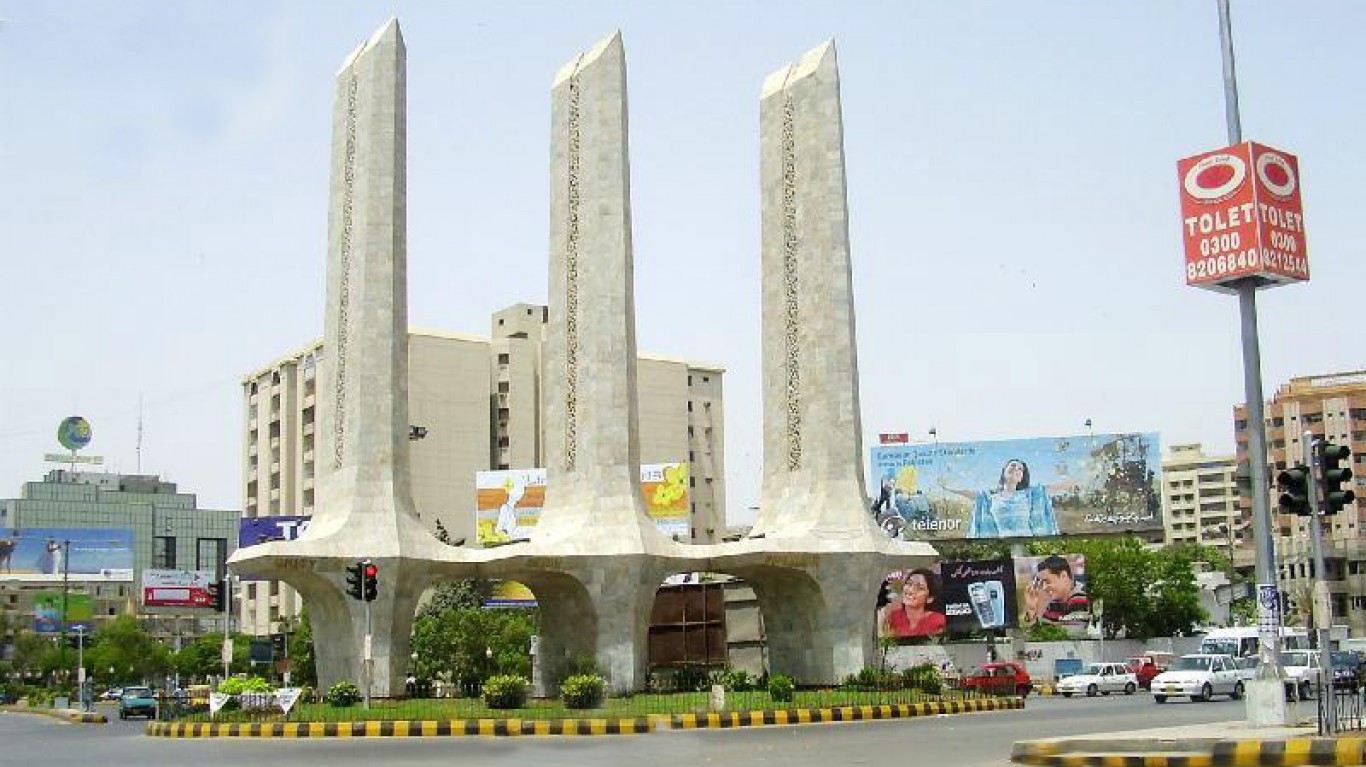
12. Karachi, Pakistan
> 2018 population: 15.4 million
> 2000-2018 population growth: +56.7%
> Pct. of Pakistan’s population: 7.7%
> Est. 2030 population: 20.43 million
Karachi is the larger of Pakistan’s two megacities, serving as both the country’s primary seaport and its commercial and industrial center. Decades of urbanization has turned this once relatively sleepy port town into a bustling, chaotic metropolis ringed by urban sprawl. The city’s residents are primarily Muslim, but owing to its cultural past, it also contains small pockets of Christians, Hindus, Parsis, Buddhists, and Jains. Major industries in the city include finance, textiles, pharmaceuticals, steel, and automotive assembly.

11. New York-Newark, United States of America
> 2018 population: 18.8 million
> 2000-2018 population growth: +5.6%
> Pct. of United States of America’s population: 5.8%
> Est. 2030 population: 19.96 million
The New York-Newark metropolitan area is the larger of the two U.S. megacities (the other one being Los Angeles-Long Beach-Santa Ana) and one of the country’s major economic, financial, and cultural centers. New York City became the country’s most populous urban areas in the early 1800s and has remained the country’s largest ever since. Major local industries include financial services, health care, real estate, retail, education, and media. In 2017, New York City was the sixth most visited city in the world.
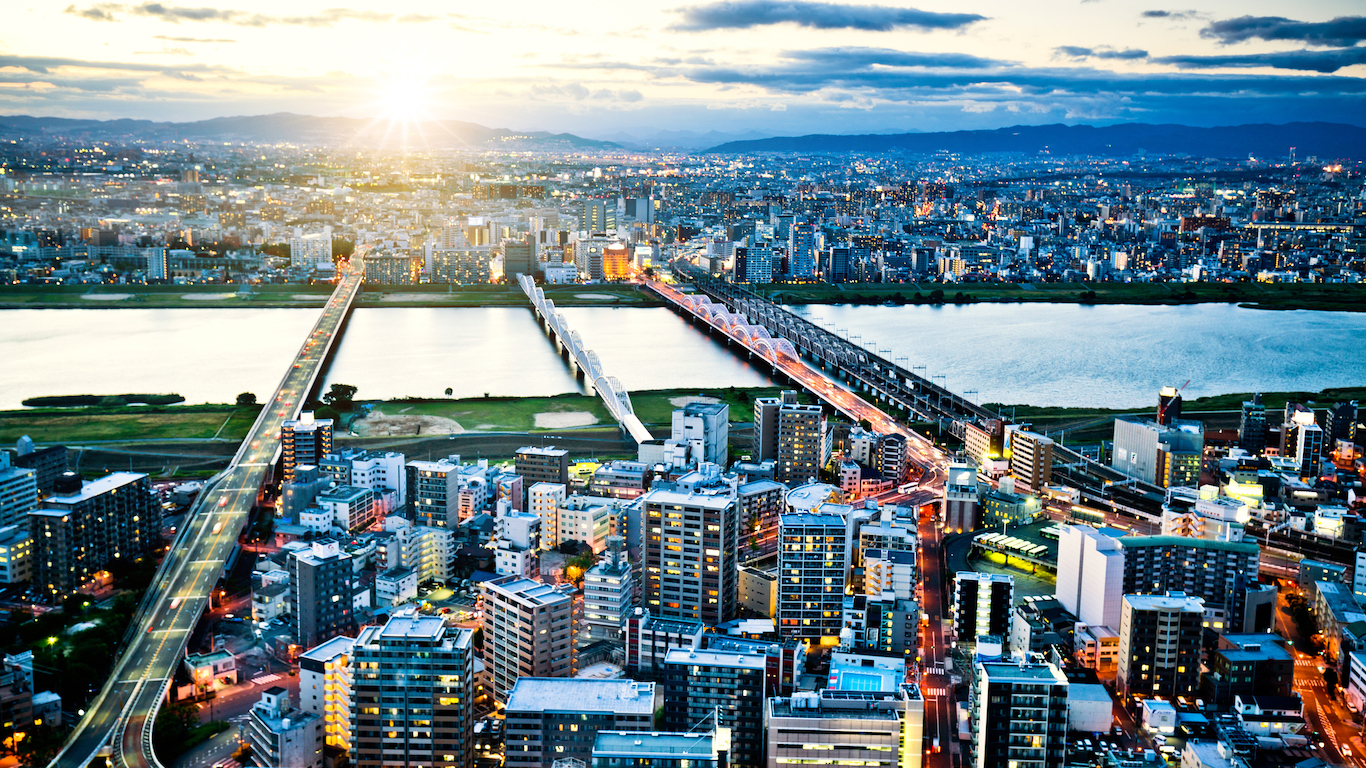
10. Kinki M.M.A. (Osaka), Japan
> 2018 population: 19.3 million
> 2000-2018 population growth: +3.3%
> Pct. of Japan’s population: 15.2%
> Est. 2030 population: 18.66 million
Osaka, the smaller of two Japanese megacities, is significantly smaller than the world’s most populous city â Japan’s capital, Tokyo. Located in south-central Japan, Osaka is a bustling but orderly port city that’s part of an industrial zone that includes neighboring Kobe and Kyoto. Once a textile town, Osaka’s economy is largely based on heavy industry, including metal fabrication, chemicals, and food processing. Osaka is also widely considered to be a city for foodies with a reputation as having the best culinary scene in Japan.
[in-text-ad-2]
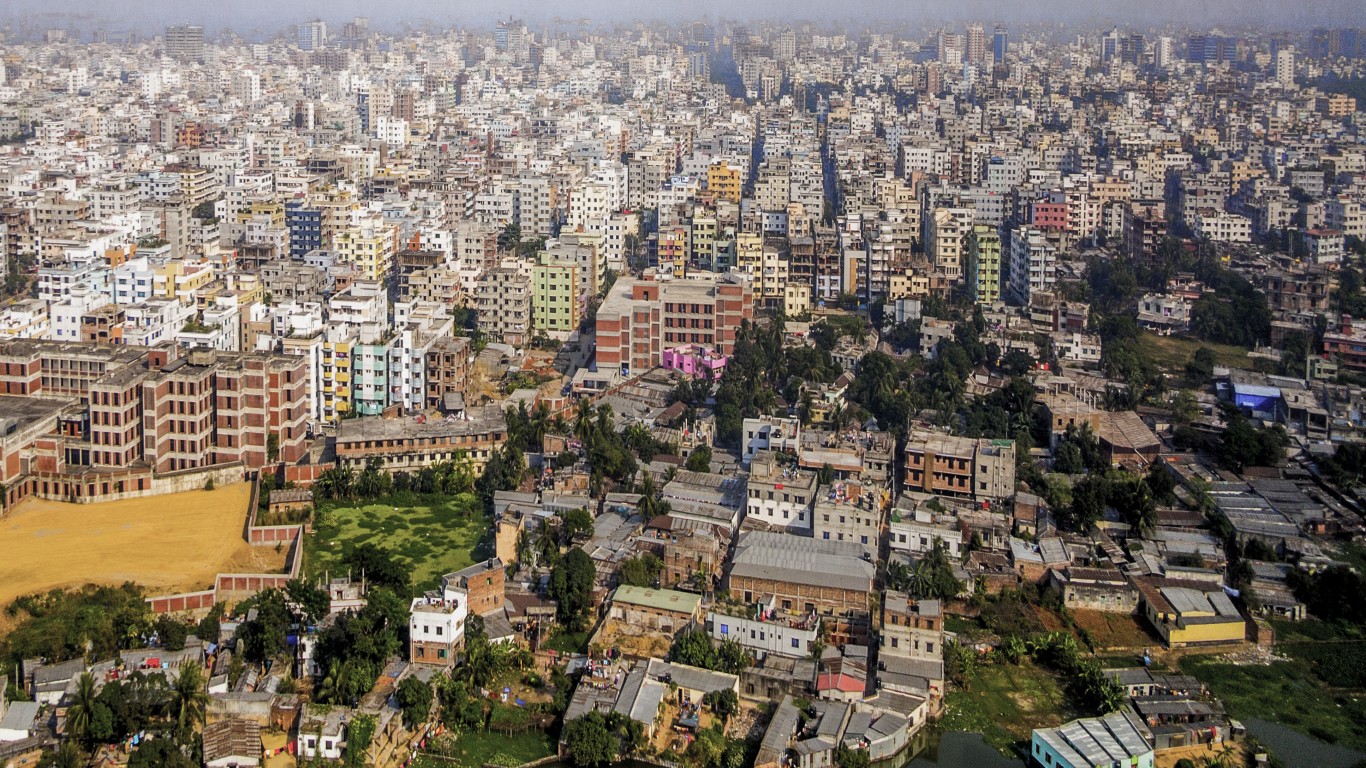
9. Dhaka, Bangladesh
> 2018 population: 19.6 million
> 2000-2018 population growth: +90.4%
> Pct. of Bangladesh’s population: 11.8%
> Est. 2030 population: 28.08 million
The centrally located river-port capital of Bangladesh is the economic, political, and educational heart of the world’s eighth most populous country. A major source of jobs in a country with a crippling unemployment rate is the garment industry, which has been the focus of workplace safety issues following the 2013 collapse of the Rana Plaza building that killed more than 1,100 garment workers. Even by megacity standards, Dhaka is a crowded place. In 2012, urban policy analyst Wendell Cox estimated that Dhaka’s population is denser than 23 other megacities, including Mumbai and Karachi, and that the densest part of Manhattan is 40% less dense.
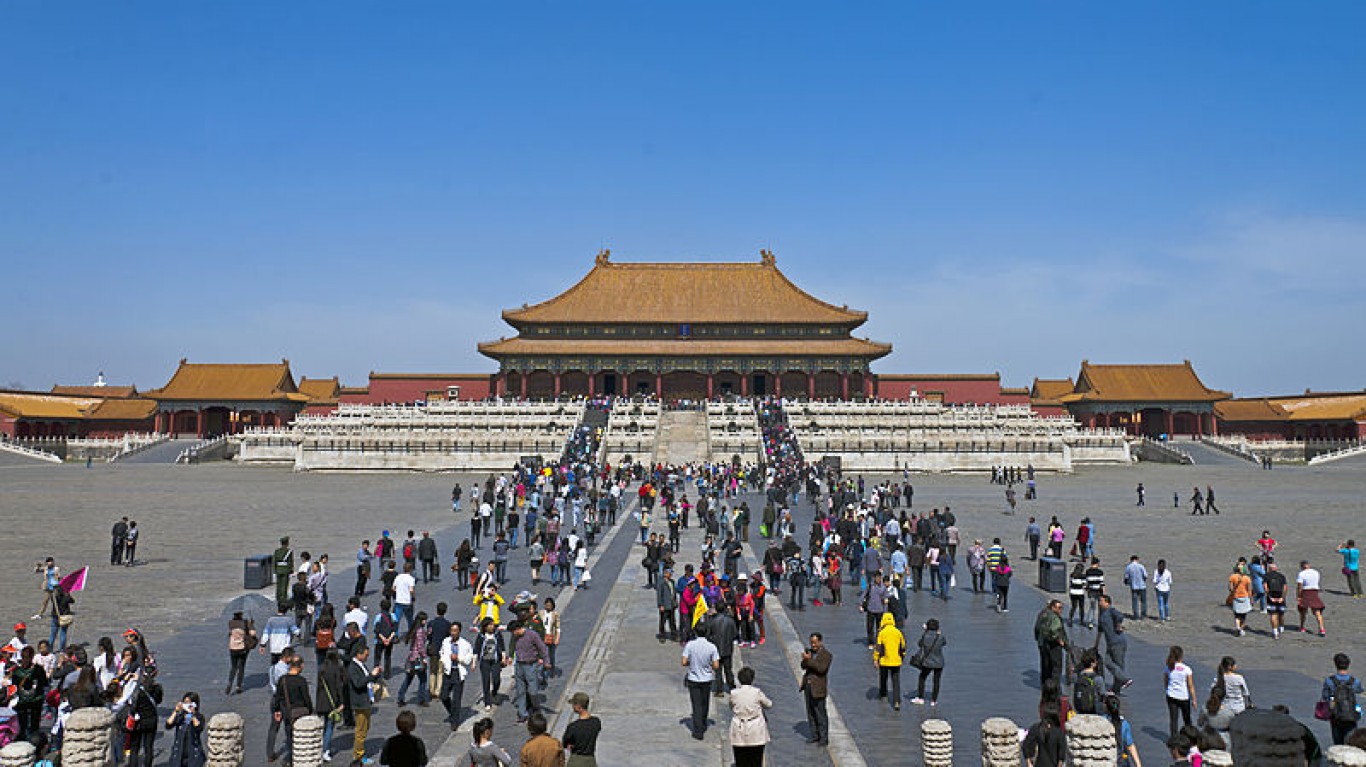
8. Beijing, China
> 2018 population: 19.6 million
> 2000-2018 population growth: +90.7%
> Pct. of China’s population: 1.4%
> Est. 2030 population: 24.28 million
In China’s most densely urbanized regions, such as the southern Pearl River Delta, it can be difficult to know where one big Chinese city ends and another begins. The country’s capital may be China’s second largest megacity, after Shanghai, but its proximity to other large cities, including the megacity of Tianjin 75 miles to the southeast, makes Beijing the core of a sprawling industrialized, traffic-choked, and heavily populated urban cluster. Beijing has been the seat of Chinese power for more than 800 years, making it one of the oldest (and certainly the biggest) political headquarters in the world.
[in-text-ad]
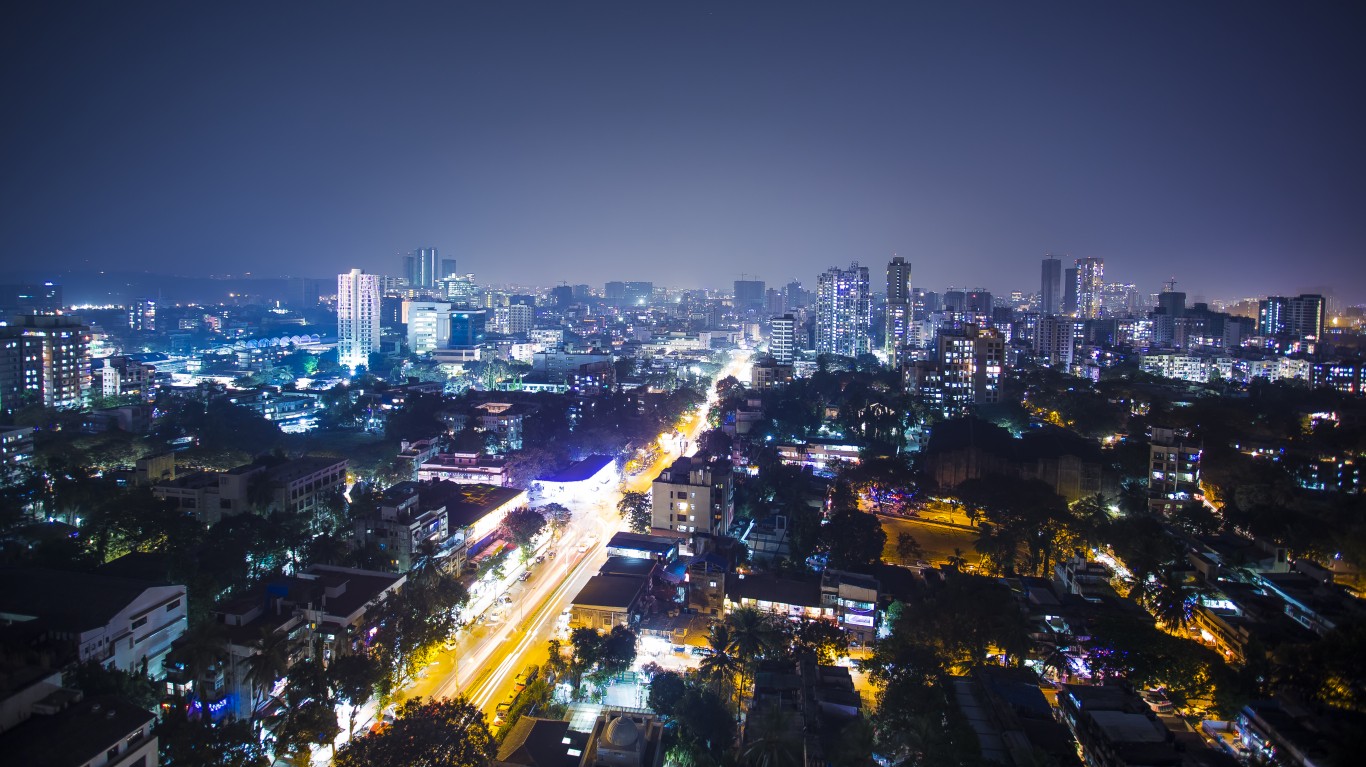
7. Mumbai, India
> 2018 population: 20.0 million
> 2000-2018 population growth: +23.7%
> Pct. of India’s population: 1.5%
> Est. 2030 population: 24.57 million
The island capital of India’s south-central Maharashtra state is the country’s main financial and commercial hub as and is home to the country’s vibrant native film industry. Historically, Mumbai was the center of the country’s cotton textile industry, but today the city has developed a more diverse economy, including a growing information technology sector. Constrained by its geography (it is spread over seven islands), Mumbai struggles to provide adequate housing and opportunities to the ever growing population of rural poor arriving to the city. After the worst flooding in a decade, experts in 2017 called on local officials to do more to control urban sprawl.
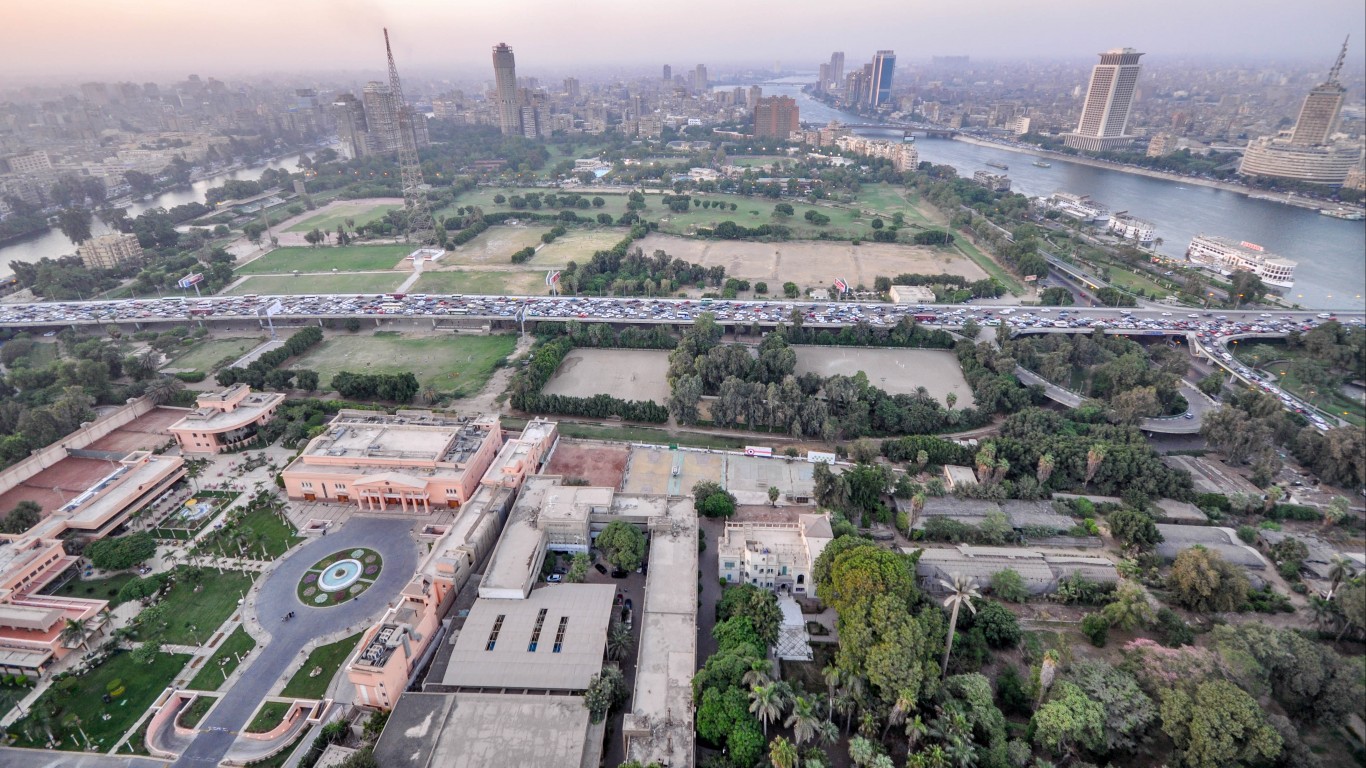
6. Al-Qahirah (Cairo), Egypt
> 2018 population: 20.1 million
> 2000-2018 population growth: +47.3%
> Pct. of Egypt’s population: 20.2%
> Est. 2030 population: 25.52 million
The largest of Africa’s three megacities has roots going back to the ancient city of Memphis, founded 4,000 years ago 14 miles southwest of Cairo. Egypt’s capital, situated 140 miles from the Mediterranean coast, was established about 1,100 years ago. The city’s economy is largely dependent on agriculture, petroleum, mining, and, most important, tourism â an industry that was pummeled in the wake of the January 2011 Arab Spring. The tourism industry has recently started to recover, though the number of foreign visitors remains below its all-time high in 2010.
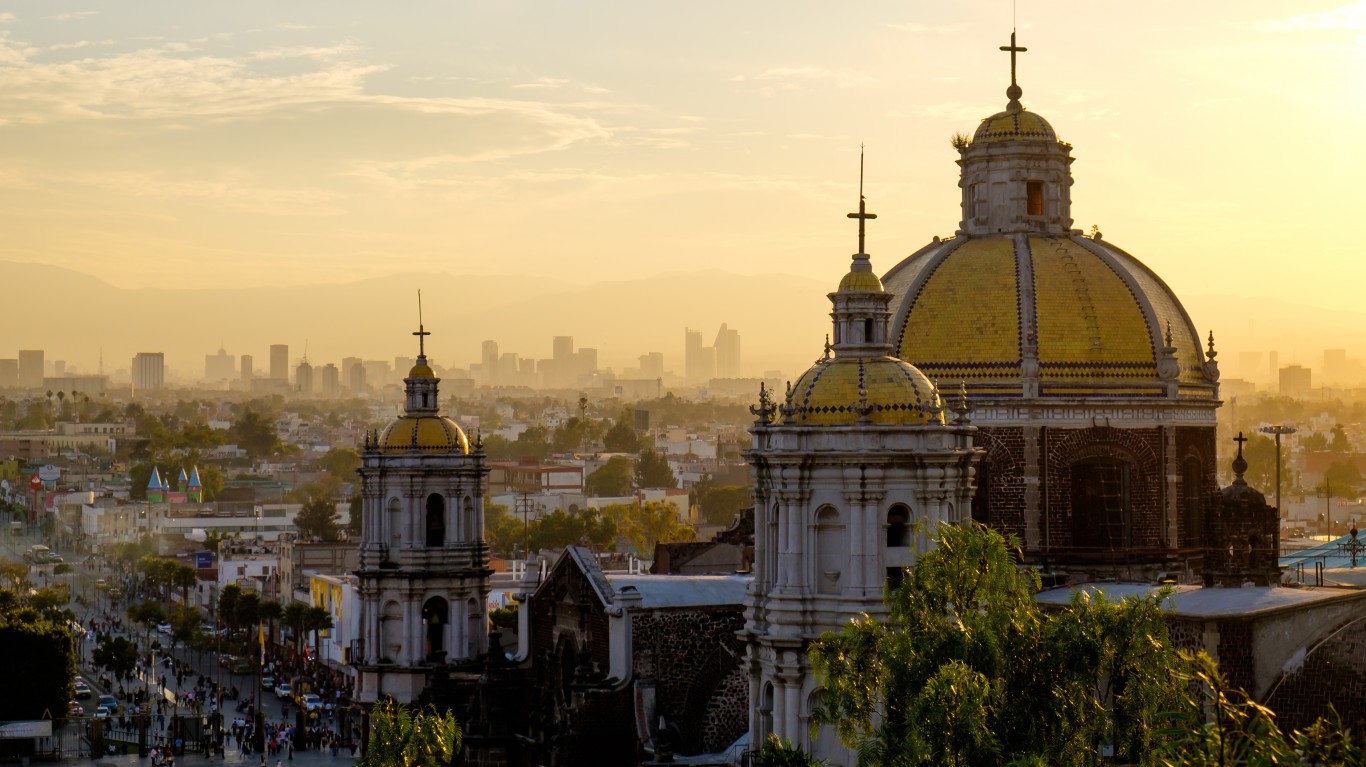
5. Ciudad de México (Mexico City), Mexico
> 2018 population: 21.6 million
> 2000-2018 population growth: +16.9%
> Pct. of Mexico’s population: 16.5%
> Est. 2030 population: 24.11 million
Mexico City is North America’s largest metropolis and the second largest of Latin America’s six megacities, barely trailing behind São Paulo. Located on an ancient lakebed in a high valley ringed by mountains, Mexico City is the economic, political, and cultural center of the country. The city’s pre-Columbian and colonial sights, as well as its cosmopolitan atmosphere and culinary treats, make it a popular destination for foreign visitors as Mexico is the sixth-most visited country in the world. In addition to being a tourist destination, the metropolitan area accounts for nearly 22% of the country’s GDP.
[in-text-ad-2]

4. São Paulo, Brazil
> 2018 population: 21.7 million
> 2000-2018 population growth: +27.2%
> Pct. of Brazil’s population: 10.3%
> Est. 2030 population: 23.82 million
The larger of Brazil’s two megacities and the most populous city in the Western Hemisphere, São Paulo is a leading Latin American commercial and industrial center, responsible for about 12% of the GDP of one of the largest economies in the world. The city has been shifting from an industrial-based economy to one focused on consumer services and technology. Located on a plateau about 36 miles from the Atlantic coast, São Paulo is notable for its dense urban skyline of glass-and-concrete high rises looming over street-level nightclubs and trendy restaurants.
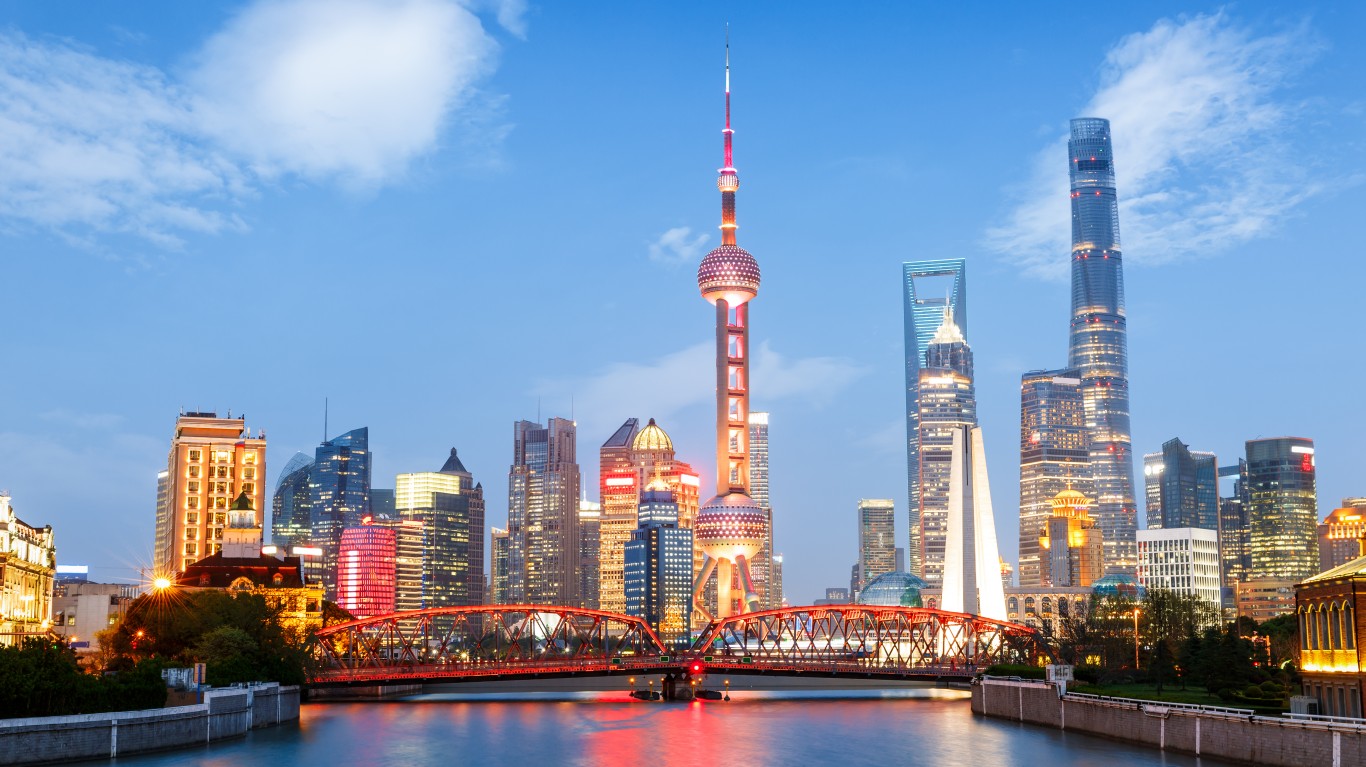
3. Shanghai, China
> 2018 population: 25.6 million
> 2000-2018 population growth: +79.6%
> Pct. of China’s population: 1.8%
> Est. 2030 population: 32.87 million
Shanghai is China’s largest city by population, and the third most populated in both Asia and the world as a whole. Located on the central east coast of the country at the mouth of the Yangtze River, Shanghai has the world’s busiest port complex in terms of cargo tonnage. Established as a city in 1297 during the Yuan Dynasty, Shanghai is also one of the oldest gateways for maritime trade. In 2017, Shanghai became the first Chinese city with a GDP over $3 trillion ($469 billion in 2017 dollars).
[in-text-ad]
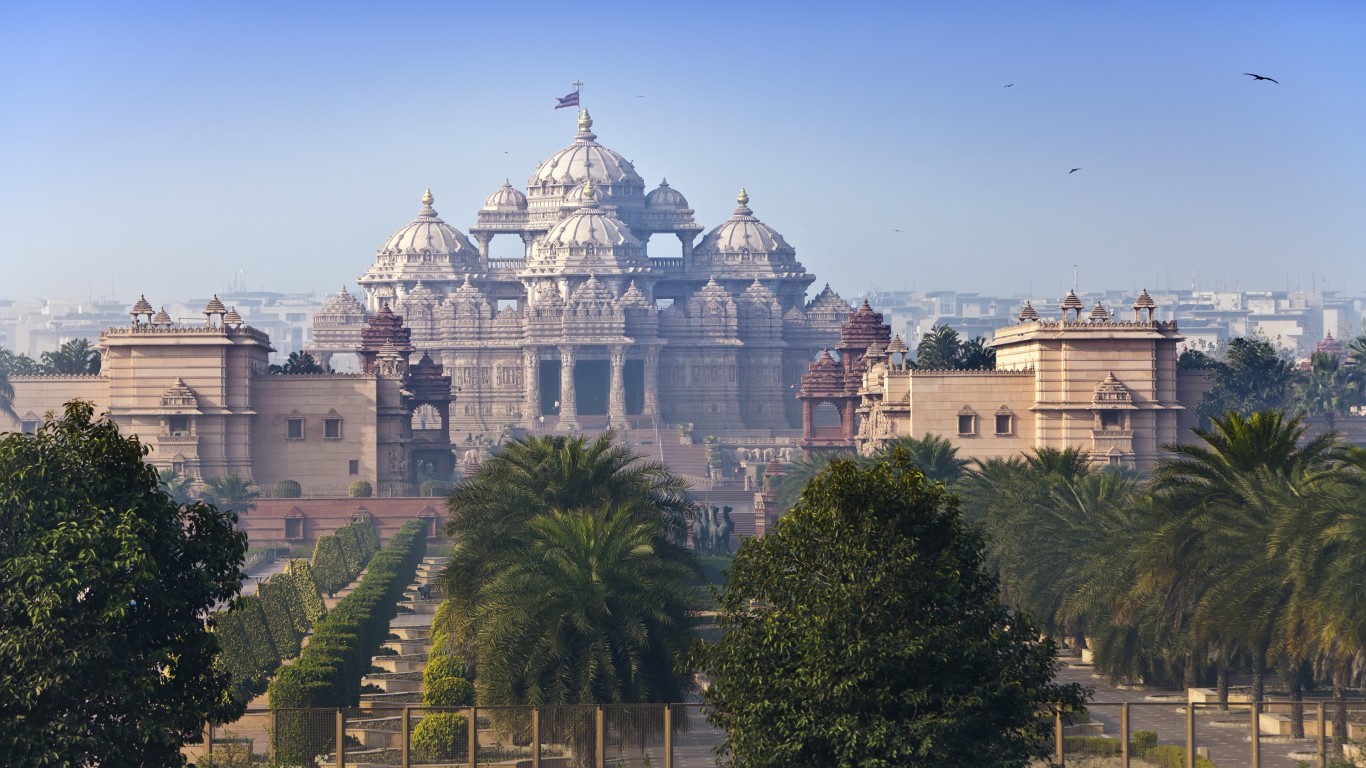
2. Delhi, India
> 2018 population: 28.5 million
> 2000-2018 population growth: +81.7%
> Pct. of India’s population: 2.1%
> Est. 2030 population: 38.94 million
Sitting on the banks of a Ganges River tributary in north-central India, Delhi is the largest of the country’s five megacities. It comprises Old Delhi in the north, a historic city known for its opulent 17th-century Mughal historical sites, and New Delhi, built in the early 20th century as the seat of the British occupation. Delhi, the political center of India, has often taken second seat to Mumbai, the country’s financial and commercial center and home to Bollywood. Recent data from U.S. think tank Brookings Institution, however, ranks Delhi far ahead of Mumbai in job growth.
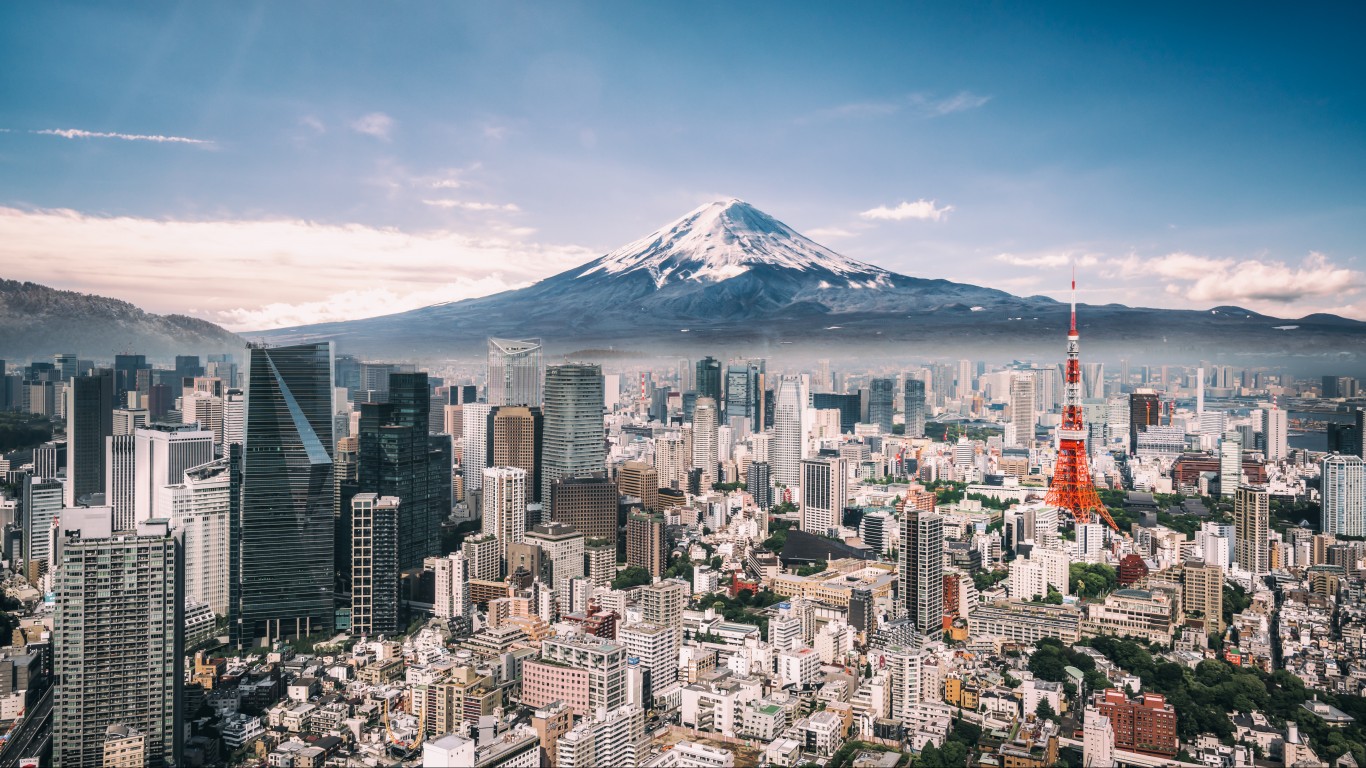
1. Tokyo, Japan
> 2018 population: 37.5 million
> 2000-2018 population growth: +8.8%
> Pct. of Japan’s population: 29.5%
> Est. 2030 population: 36.57 million
Tokyo has been the reigning champion of the world’s megacities for decades. The industrial and political center of the world’s third largest economy has nearly the population of California crammed into a space smaller than the size of Connecticut. But its days as human history’s largest urban agglomeration are numbered as Japan’s population is projected to shrink, while Delhi’s population continues to expand. The United Nations predicts that by 2029, India’s capital territory will overtake Tokyo as the biggest megacity in the world.
Methodology
The population of New York City proper, for example, is 8.6 million, according to the latest U.S. Census Bureau data from 2017. But the population of the city’s metropolitan area, also known by the U.S. Census Bureau as the metropolitan statistical area, is 19.5 million. This metro area stretches from the tip of Long Island to Allentown, Pennsylvania (191 miles to the west), and from Tuckerton, New Jersey, to Kingston, New York, a 160-mile drive to the north.
In many cases, there is a third category, called the urban agglomeration, which is defined by the U.N. as the contiguous built-up area with urban density that stretches beyond the city boundaries across administrative zones over county and state lines. A suburb located in a neighboring state that is close enough for residents to commute to and from a city would not be considered part of the urban agglomeration but would often be considered part of a city’s metropolitan area.
Based on the U.N. data, only two cities in the Western Hemisphere make the top 10 world’s most populous cities: Mexico City, with its metropolitan area population size of 21.6 million and São Paulo, with a population size of 21.7 million. Seven of the top 10 megacities are in Asia, while Cairo’s metro area is on the list at No. 7 with 20.1 million.
In order to maintain an apples-to-apples comparison of city population sizes, we are relying solely on U.N. estimates.
Take This Retirement Quiz To Get Matched With An Advisor Now (Sponsored)
Are you ready for retirement? Planning for retirement can be overwhelming, that’s why it could be a good idea to speak to a fiduciary financial advisor about your goals today.
Start by taking this retirement quiz right here from SmartAsset that will match you with up to 3 financial advisors that serve your area and beyond in 5 minutes. Smart Asset is now matching over 50,000 people a month.
Click here now to get started.
Thank you for reading! Have some feedback for us?
Contact the 24/7 Wall St. editorial team.
 24/7 Wall St.
24/7 Wall St. 24/7 Wall St.
24/7 Wall St. 24/7 Wall St.
24/7 Wall St. 24/7 Wall St.
24/7 Wall St.


